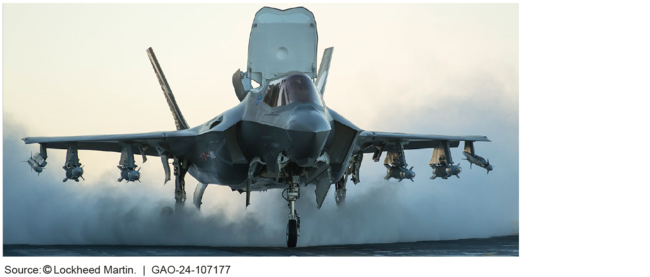F-35 Joint Strike Fighter: More Actions Needed to Explain Cost Growth and Support Engine Modernization Decision
Fast Facts
DOD's effort to modernize its F-35 aircraft continues to face challenges that we identified in our prior work. We testified that:
The program's cost estimate for modernization grew by billions of dollars, and DOD didn't fully report what caused this increase
The program hasn't fully installed the hardware and software needed for future aircraft upgrades because of delays developing the needed technologies
Issues with the aircraft's current cooling system will increase wear on the engine, reduce the engine's life, and potentially add billions in maintenance costs
We previously made recommendations to address these issues.

Highlights
What GAO Found
The Department of Defense's (DOD) effort to modernize the F-35's capabilities, an effort known as Block 4, continues to experience cost and schedule growth. Block 4 was originally defined as 66 capabilities and estimated to cost $10.6 billion, with development expected to be completed in fiscal year 2026. In May 2023, GAO reported that Block 4 costs had grown to $16.5 billion and the effort was now estimated to be completed in 2029. Additionally, DOD has added new capabilities to Block 4 nearly every year, so Block 4 is now composed of 80 capabilities. DOD's report to Congress on the Block 4 effort does not distinguish higher-than-expected costs for previously planned Block 4 capabilities from growth due to adding capabilities. Consequently, Congress does not have a clear picture of the reason for the growing F-35 modernization costs.
The Block 4 effort has also continued to experience developmental delays for important technology updates. For example, the F-35 program has yet to install Technology Refresh 3 (TR-3)—the $1.64 billion suite of upgraded hardware and software technologies critical to enabling many future Block 4 capabilities—on production aircraft. The services will not accept aircraft until TR-3 is installed.
An F-35B Exercising Its Short Takeoff and Vertical Landing Capability

The program has announced plans to upgrade the F-35's engine and is exploring options to modernize the power and thermal management system that is used to cool aircraft subsystems that generate heat. The current cooling system is overtasked, requiring the engine to operate beyond its design parameters. The extra heat is increasing the wear on the engine, reducing the engine's life, and adding a projected $38 billion in maintenance costs over the life of the aircraft.
The program has assessed some engine and cooling improvement options but the military services have not fully defined future aircraft cooling requirements. By defining these requirements and obtaining this and other key information, DOD and the services would be more informed about performance, cost, and technical implications. Furthermore, because the original development program is scheduled to transition to sustainment and would be subject to less oversight, GAO has recommended that DOD manage the engine and thermal management modernization as a separate program, with its own distinct cost, schedule, and performance baselines.
Why GAO Did This Study
The F-35 Lightning II Joint Strike Fighter program remains DOD's most expensive weapon system program. It is estimated that it will cost over $1.7 trillion to buy, operate, and sustain these aircraft.
The F-35 program manages a family of strike fighter aircraft that integrates stealth technology with advanced sensors and computer networking capabilities. DOD plans to acquire 2,470 F-35s to replace several other aircraft used by the Air Force, Navy, and Marine Corps. As of December 2023, the program has delivered over 900 aircraft to the U.S. services, allied partners, and foreign military sales customers.
DOD is 5 years into a development effort to modernize the F-35 aircraft's capabilities and is considering options for modernizing the F-35's engine.
This testimony discusses acquisition-related risks in the F-35 modernization efforts. It is largely based on GAO's May 2023 report (GAO-23-106047) on F-35 acquisition.
Recommendations
In May 2023, GAO made seven recommendations to DOD aimed at improving Block 4 cost reporting and engine and thermal management modernization efforts. DOD concurred with three, partially concurred with three, and did not concur with one recommendation that the program set engine modernization requirements before awarding a contract. GAO previously made a matter to Congress to require Block 4 reporting until its completion. GAO continues to believe that DOD should fully implement these recommendations.
